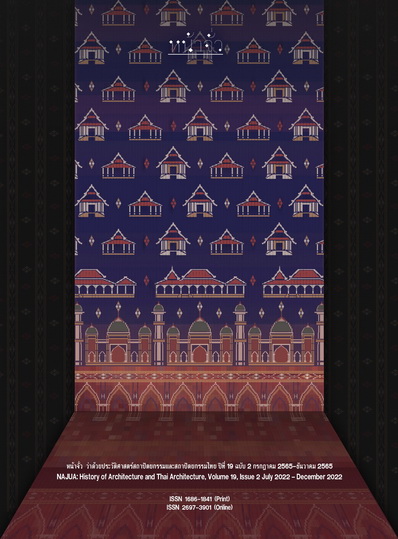The Making Process of Duong Lam Ancient Village Cultural Guide Map
Main Article Content
Abstract
Duong Lam Ancient Village is popular with Vietnamese and foreign tourists. It reflects the roots of Vietnam's traditional culture, both in terms of the settlement history of the village, such as traditional architecture with a distinctive identity, public buildings, religious buildings and houses as well as traditional agriculture. Over the past twenty years, various agencies have studied, surveyed, and measured the rural fabric of the village including mapping and architectural surveys.
Drawing upon previous studies and surveys together with aerial photographs and satellite imagery, the research aims to create the Cultural Guide Map of Duong Lam Ancient Village that will not only provide information for tourists. But it will also demonstrate the analysis of both quantitative and qualitative data on the village’s key elements and environments. The Map shows the location of ancient houses and other public buildings that have been registered as national heritage. Some of the village's identity is simply presented and communicated through mapping.
The add-on products derived from this research are postcards, A4-size maps, and commemorative T-shirts. All products will have a QR code that links to a social media platform, that provides further information about the village and allows users to interact with the page. The products will be available to purchase at the Information Centers of Duong Lam Village: Café NOK, Tea Shop next to the village courtyard, and Café Homestay.
Downloads
Article Details

This work is licensed under a Creative Commons Attribution-NonCommercial-NoDerivatives 4.0 International License.
References
Bui Thiet. Vietnamese village: Bat Trang commune. Hanoi: Cultural Publishing House, 1993.
Dinh Quoc Phuong. Village architecture in Hanoi: Patterns and changes. Hanoi: Science and Technics Publishing House, 2010.
Do Thi Hao. “Bat Trang village.” In The craft streets and villages in Thang Long, 5-30. Edited by Tran Quoc Vuong. Hanoi: Ministry of Cultural and Information, 1993.
Do Thi Hao., ed. Bat Trang-the land of pottery. Hanoi: Social Science Publishing House, 1989.
Do Van Thin, and Nguyen Mau Vu, eds. History of Bat Trang’s communism and the people. Hanoi: Bat Trang, 2002.
Fanchette, Sylvie. Ha Noi, a metropolis in the making: The breakdown in urban integration of villages. Marseille: IRD Editions, 2016.
Fanchette, Sylvie and Nicholas Stesman. Discovering craft villages in Vietnam. Hanoi: IRD Editions, 2010.
Institue of International Culture, Showa Women’s University (Japan). Lang co DUONG LAM (Ancient village Duong Lam). Hanoi: Thuong mai Ha Tay, 2008.
Japan Consortium for International Cooperation in Cultural Heritage. Preservation of Duong lam ancient village. Accessed December 20, 2022. Available from https://www.jcicheritage.jp/en/project/asia_donlam/
Le Thanh Huong. Duong Lam: An ancient Village in Hanoi. Hanoi: The Gioi Publishers, 2012.
Ministere de la Construction Institut de Recherche en Architecture. Conservation du Patrimoine architectural et Paysager de Hanoi. Hanoi: Editions de la Construction, 1999.
Nara National Research Institute for Cultural Properties. Hamlet survey report, Duong Lam village. Nara: Independent Administrative Institution, National Institute of Cultural Heritage, 2009.
Ngo Huy Giao. “Bat Trang bricks in Historic architecture.” Ha Noi Moi Newspaper (September 3, 2000).
Nguyen Ba Dang and Nguyen Vu Phuong. Traditional Vietnamese Architecture. Hanoi: The Gioi Publishers, 2004.
Phan Huy Le, Nguyen Dinh Chien, and Nguyen Quang Ngoc. Bat Trang ceramic: 14th–19th century. Hanoi: The Gioi Publisher, 1995.
Trinh Phu Son. “When does the ancient Bat Trang’s suffering finish?.” People Army Newspaper (February 24, 2002): 3.


